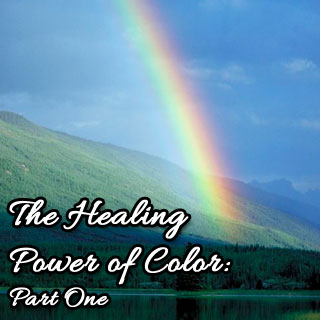 The old adage of “healer heal thyself” has never been more appropriate than when picturing yourself “in” a specific color, albeit surrounded by the walls within your home or office or the wardrobe that clothes your body. Remember the 1980s when the rage was to learn about your colors, whether you were spring, summer, fall (autumn) or winter, based upon the spectrum of colors that enhanced your skin tone?
The old adage of “healer heal thyself” has never been more appropriate than when picturing yourself “in” a specific color, albeit surrounded by the walls within your home or office or the wardrobe that clothes your body. Remember the 1980s when the rage was to learn about your colors, whether you were spring, summer, fall (autumn) or winter, based upon the spectrum of colors that enhanced your skin tone?
Color therapy, the use of colors to heal, also known as chromotherapy, can be very healing. It is classified as a vibrational healing modality and incorporates the use of “Chi” energies within living organisms such as plants, gemstones and crystals, water, sunlight and sound. Simply put, color is a form of light that is visible. It is electromagnetic energy with each color of the rainbow carrying its own unique healing property.
The Color Spectrum
Scientists like Dr. Max Luscher during the early 1900’s, and twentieth century author and spiritual and metaphysical teacher Ted Andrews, among others, studied the effects of color on behavior as well as the associated physical, emotional, mental and spiritual characteristics to colors.
Every color has its own characteristics, and hence a capability of affecting different energies within the human essence. Colors with a higher frequency are said to affect the higher frequencies of the brain. Other colors, those said to have a lower frequency, can affect the systems or energies of the physical body. So, what does each of the colors represent?
Looking at the physical aspects, green and light blue have been associated with restfulness, while orange has been viewed as revitalizing and red stimulating. Emotionally, sky blue and turquoise have been viewed as restful, with peach being revitalizing and orange stimulating. From the mental perspective, indigo has been associated with restfulness and emerald green is viewed as revitalizing and yellow as stimulating. Spiritually, blue is viewed as restful, with gold being seen as revitalizing and violet and purple as stimulating.
Working With Colors in Our Daily Lives
Colors, therefore, can promote restfulness, or they can be stimulating and revitalizing. So, how do we work with color to use it to our best and highest good as well as to the best and highest good of the universe as a whole? Working with colors to improve our daily lives involves two steps. The first step is to understand the individual properties of each color. The second step involves learning and applying certain techniques that will allow us to project and absorb color. If we wish to go beyond this, we can learn to sensitize ourselves to color and become more knowledgeable about color as a form of personal healing.
Understanding Color Properties: Step One
The color white, or absence of color for some, contains the entire light spectrum. Its keynotes are purification, purity and amplification. It is perceived as strengthening and is also cleansing and purifying to the entire energy system. It also amplifies the effects of any other color when used in concert with another color.
Black is perceived as offering protection. It helps to ground and strengthen us. When used with white, black is effective in balancing polarity. Those of us who are particularly sensitive energetically gravitate to black to ground and calm us. When using black, use it in conjunction with another color and not by itself.
Red strengthens the life force within us. Red is commonly associated with the circulatory system of the body and is said to stimulate energy and metabolism. Red, the color of our base or grounding chakra, awakens our physical life force. For balance, use red with green.
The color green is associated with balance, growth and calming. Green helps us grow, helping to calm the sympathetic nervous system and control inflamed conditions of the body. Green is also associated with peace and hope. The color green can be used in your home or office to promote a feeling of restfulness, particularly for those whose professions are more cerebral in nature.
Blue has been said to promote peace and assist with aspirations and creative expression. It is relaxing and quieting to our energies and has been associated with the body’s respiratory system. If you are prone to hypertension, you may want to surround yourself with blue. If you are feeling lonely, wear something blue or take a walk under a vibrant blue sky. The color blue has also been said to be one of the most universally healing colors for children. Feeling stagnant, pair blue with a color on the orange-red spectrum for an awakening of your artistic expression and some inspiration.
Yellow, the last of the primary colors, is associated with mental activity and intellectual power. Physically it is attributed to the digestive system and also to left brain activity. Along the chakra spectrum, yellow is associated with the solar plexus which is known as the power chakra. The golden yellow tones are said to be healthful to both the body and the mind, facilitating learning.
Over the next couple of weeks, observe how colors affect you personally and watch for Part Two of “The Healing Power of Color” to learn some techniques for applying color therapy in your life.

